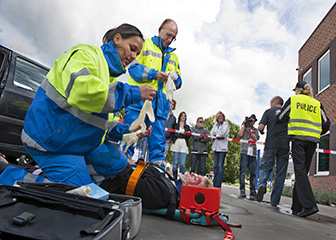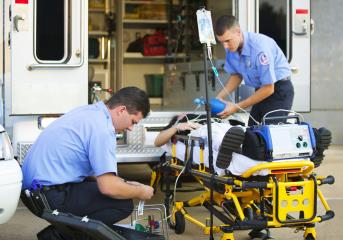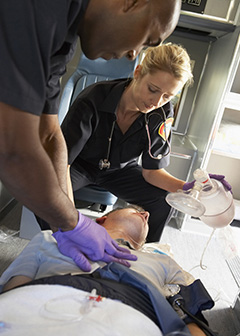
EMTs and paramedics need to be physically fit as their job requires bending, lifting, and kneeling.
Emergency medical technicians (EMTs) and paramedics typically complete a postsecondary educational program. All states require EMTs and paramedics to be licensed in the state in which they work; requirements vary by state.
Education
High school students interested in becoming EMTs or paramedics should take courses in life sciences and consider becoming certified in cardiopulmonary resuscitation (CPR). Some high schools offer EMT training through vocational or technical education programs.
EMTs typically need to complete a postsecondary education program to enter the occupation. Program applicants usually need a high school diploma or equivalent and certification in CPR and basic life support (BLS). However, program entry requirements vary by state.
Most EMT programs lead to a nondegree award. They vary in length but typically take less than 1 year for EMT-Basic certification and up to 2 years for EMT-Intermediate certification. Programs are offered by technical institutes, community colleges, universities, and facilities that specialize in emergency care training. Some instruction may take place in a hospital or ambulance setting.
EMT-Basic programs cover topics such as assessing patients’ conditions, handling emergencies, and using field equipment. Programs that do not require BLS and CPR certification prior to admission include instruction that leads to those certifications as part of the program. EMT-Intermediate programs require additional instruction for advanced skills, such as using complex airway devices, intravenous fluids, and some medications.
Paramedic postsecondary programs require applicants to have EMT-Intermediate certification. Most programs at community colleges typically lead to a nondegree award or an associate’s degree. Some programs are offered by 4-year universities and lead to a bachelor’s degree. Paramedic programs include courses such as anatomy and physiology, EKG interpretation, and maintaining airflow. They typically include supervised field experience.
Licenses, Certifications, and Registrations
All states require EMTs and paramedics to be licensed; requirements vary by state. Most states require candidates to be certified, but others require passage of an equivalent state exam. States also may have other requirements for licensing, such as a minimum age and passing a background check. Information on state licensing board requirements is available from CareerOneStop.
Employers typically require job candidates to have a driver’s license and may prefer that they have ambulance driver certification. Information on certifications is available from CareerOneStop.
Other Work Experience
Paramedics typically need work experience as an EMT prior to entering a paramedic education program.
Working as a volunteer EMT or paramedic may be helpful in getting experience for employment in these occupations.
Advancement
With additional education, paramedics may transfer into other healthcare occupations. For example, paramedic-to-RN programs offer an accelerated pathway to becoming a registered nurse.
Important Qualities
The following are examples of qualities that are important for these workers to perform their duties. For more information, visit the Employment Projections (EP) skills data page.
Communication skills. EMTs and paramedics must listen to patients describe their injuries and illnesses and to dispatchers and others conveying information. They also need to provide clear instruction and explain procedures.
Compassion. EMTs and paramedics must be able to provide care and emotional support to patients who may be in life-threatening situations or under extreme mental distress.
Interpersonal skills. EMTs and paramedics must be able to coordinate activities with other members of their team. They also interact with a variety of people when responding to calls for assistance.
Physical strength. EMTs and paramedics must be comfortable bending, lifting, and kneeling over the course of their shift.
Problem-solving skills. EMTs and paramedics must evaluate patients’ symptoms and determine the appropriate treatment.
 United States Department of Labor
United States Department of Labor








